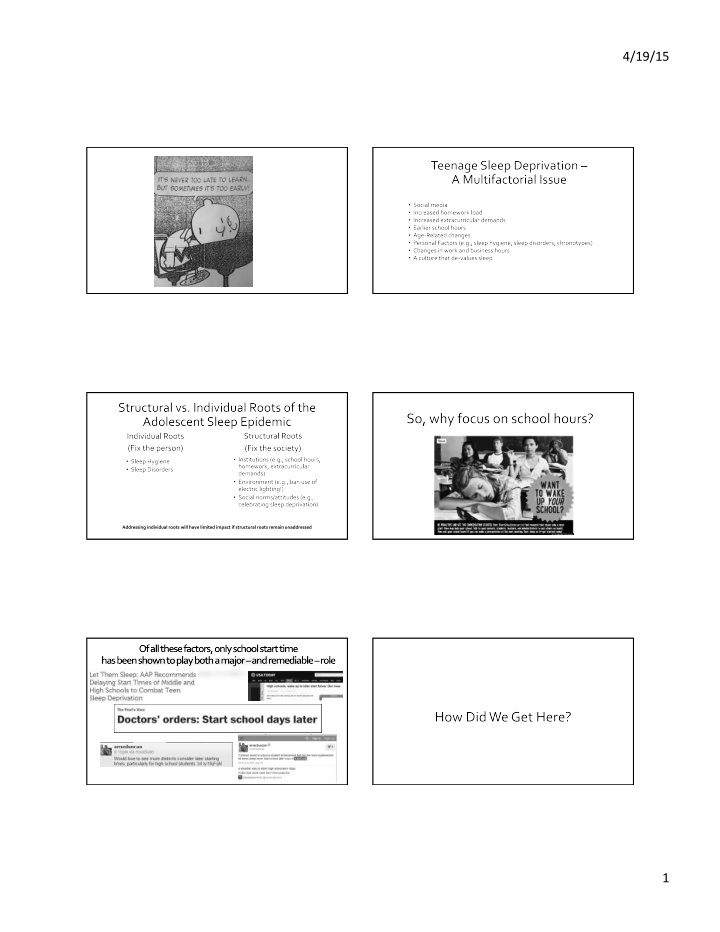



4/19/15 ¡ Addressing ¡individual ¡roots ¡will ¡have ¡limited ¡impact ¡if ¡structural ¡roots ¡remain ¡unaddressed ¡ 1 ¡
4/19/15 ¡ We ¡don’t ¡ measure ¡what ¡ we ¡don’t ¡think ¡ matters ¡ Whatever ¡we ¡do ¡now, ¡we ¡haven’t ¡always ¡done. ¡ And ¡we ¡haven’t ¡done ¡it ¡very ¡long. ¡ 2 ¡
4/19/15 ¡ Not ¡all ¡states ¡had ¡ In ¡1900 ¡an ¡estimated ¡6-‑11% ¡ By ¡the ¡early ¡1970s ¡high ¡ compulsory ¡elementary ¡ of ¡teenagers ¡attended ¡high ¡ school ¡enrollment ¡rates ¡ school ¡attendance ¡until ¡1917 ¡ school. ¡ ¡ were ¡about ¡90% ¡ 1953: ¡REM ¡sleep ¡discovered; ¡Dement ¡ 1940-‑1970: ¡More ¡students, ¡fewer ¡schools, ¡ describes ¡“cyclical ¡nature” ¡of ¡sleep ¡ longer ¡commutes ¡ 1970: ¡Dement ¡founds ¡the ¡first ¡sleep ¡ research ¡center, ¡Stanford ¡ 1970-‑1990: ¡Recession, ¡fuel ¡costs, ¡ 1970-‑1990: ¡Carskadon ¡et ¡al. ¡conduct ¡initial ¡ desegregation, ¡suburbanization, ¡budget ¡ research ¡on ¡teen ¡sleep; ¡early ¡research ¡on ¡ cuts ¡lead ¡to ¡recycling ¡buses, ¡staggered ¡ sleep’s ¡role ¡in ¡learning, ¡memory ¡ bell ¡times ¡ 1990s: ¡Early ¡reports ¡of ¡delayed ¡phase ¡ 1990s: ¡Continued ¡moves ¡to ¡earlier ¡hours ¡ preference ¡in ¡teens ¡and ¡impact ¡of ¡school ¡ schedules ¡on ¡sleep, ¡health, ¡learning ¡ 1993 ¡First ¡call ¡for ¡later ¡start ¡times ¡by ¡ Minnesota ¡Medical ¡Association ¡ KEY ¡LESSONS ¡FROM ¡HISTORY ¡ ¡ ¡ ¡ ¡ • Everyone ¡hasn’t ¡“always” ¡started ¡school ¡so ¡early. ¡ • The ¡shift ¡to ¡early ¡hours ¡occurred ¡before ¡we ¡knew ¡about ¡teen ¡sleep ¡needs ¡and ¡ patterns. ¡ ¡ ¡ • Moves ¡to ¡earlier ¡hours ¡primarily ¡reflected ¡budgetary ¡considerations, ¡not ¡sleep, ¡ health, ¡or ¡well-‑being, ¡or ¡even ¡adult ¡convenience. ¡ ¡ ¡ ¡ ¡ ¡ ¡ ¡ ¡ ¡ 3 ¡
4/19/15 ¡ The ¡average ¡U.S. ¡high ¡school ¡ begins ¡around ¡8 ¡a.m. ¡ ¡ Many ¡schools ¡begin ¡in ¡the ¡7 ¡a.m. ¡ hour ¡ ¡ Wake-‑up ¡and ¡commute ¡times ¡are ¡ even ¡earlier ¡– ¡sometimes ¡by ¡ hours ¡ Note: ¡ When ¡ students ¡ get ¡more ¡ sleep, ¡ homework ¡ takes ¡less ¡ time ¡ Source: ¡Moore, ¡ Start ¡School ¡ Later, ¡Inc. ¡ 4 ¡
4/19/15 ¡ -‑-‑ Arthur ¡Schopenhauer ¡ 5 ¡
4/19/15 ¡ Sleep ¡is ¡for ¡the ¡weak ¡and ¡unmotivated ¡ ¡ (Besides, ¡teenagers ¡are ¡lazy) ¡ Source: ¡52 nd ¡Annual ¡Cooperative ¡Conference ¡for ¡School ¡Administrators. ¡Aug. ¡13, ¡2013. ¡ ¡ 1996: ¡Edina, ¡MN ¡ 1997. ¡Minneapolis ¡Public ¡Schools ¡ 2003. ¡Wilton, ¡CT. ¡ 2015. ¡Approximately ¡1,000 ¡schools ¡in ¡70 ¡districts ¡ Wahlstrom,2014; ¡Owens ¡et ¡al., ¡2014 ¡ 6 ¡
4/19/15 ¡ • Reframe ¡sleep ¡and ¡school ¡ hours ¡as ¡public ¡health ¡ problems, ¡not ¡negotiable ¡ school ¡budget ¡items ¡ ¡ 7 ¡
4/19/15 ¡ MULTI-‑PRONGED ¡ APPROACH ¡ National ¡ • Legislation ¡(e.g., ¡ZZZs ¡to ¡As ¡Act) ¡ • Position ¡Statements ¡(e.g., ¡AAP, ¡DOE) ¡ • Litigation ¡(?) ¡ • Education ¡ ¡ • Grassroots ¡Activism ¡ State ¡ • Legislation ¡ • Position ¡Statements ¡(e.g., ¡state ¡medical ¡society) ¡ Diverse ¡players ¡(Community ¡advocates, ¡educators, ¡ • Litigation ¡(?) ¡ health ¡professionals, ¡sleep ¡researchers, ¡ policymakers) ¡ • Grassroots ¡Activism ¡ • Education ¡ Local ¡ • Legislation ¡ • Position ¡Statements ¡(e.g., ¡local ¡board ¡of ¡health) ¡ • Litigation ¡(?) ¡ ¡ • Grassroots ¡Activism ¡ • Education ¡ Patient ¡Education ¡ Wider ¡ ¡Public/Professional ¡Outreach ¡ Join ¡with ¡local ¡advocacy ¡groups ¡ Be ¡available ¡as ¡a ¡source ¡for ¡school ¡ board, ¡city, ¡county, ¡state, ¡and ¡national ¡ hearings ¡ Encourage ¡professional ¡organizations ¡ to ¡issue ¡policy ¡statements ¡ 8 ¡
Recommend
More recommend